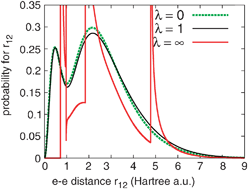Intracule densities in the strong-interaction limit of density functional theory
Abstract
The correlation energy in density functional theory can be expressed exactly in terms of the change in the probability of finding two electrons at a given distance r12 (intracule density) when the electron–electron interaction is multiplied by a real parameter λ varying between 0 (Kohn–Sham system) and 1 (physical system). In this process, usually called adiabatic connection, the one-electron density is (ideally) kept fixed by a suitable local one-body potential. While an accurate intracule density of the physical system can only be obtained from expensive wavefunction-based calculations, being able to construct good models starting from Kohn–Sham ingredients would highly improve the accuracy of density functional calculations. To this purpose, we investigate the intracule density in the λ → ∞ limit of the adiabatic connection. This strong-interaction limit of density functional theory turns out to be, like the opposite non-interacting Kohn–Sham limit, mathematically simple and can be entirely constructed from the knowledge of the one-electron density. We develop here the theoretical framework and, using accurate correlated one-electron densities, we calculate the intracule densities in the strong interaction limit for few atoms. Comparison of our results with the corresponding Kohn–Sham and physical quantities provides useful hints for building approximate intracule densities along the adiabatic connection of density functional theory.

- This article is part of the themed collection: Explicit-r12 correlation methods and local correlation methods

 Please wait while we load your content...
Please wait while we load your content...